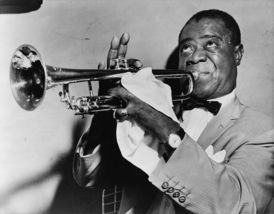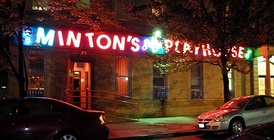Minton's Playhouse
Henry Minton, a tenor saxophonist and the first black delegate to Local 802 of the musicians’ union, opened Minton’s Playhouse in 1938. Located on 118th street at Saint Nicholas Avenue in Harlem, adjacent to the Hotel Cecil, the Playhouse was a frequent temporary residence of musicians passing through New York. In 1940, Minton hired big band musician Teddy Hill to organize the music policy for his club and help improve a lagging business. Hill quickly made Kenny Clarke the band leader, giving him full artistic license. Clarke in turn brought trumpeter Joe Guy, bassist Nick Fenton, and local pianist at the time Thelonius Monk into the group. It was then that Minton’s history as the playground of New York jazz and the birthplace of bebop began.
Because of Minton’s connections to the union, musicians were able to experiment freely at the club without fear of being fined by the union delegate for playing without pay. Thus, musicians from nearby big band theaters like the Apollo and the Paramount made Minton’s their after hours hotspot (the club was open until 4am), where musical experimentation and southern-style food was in abundance. Minton’s was particularly famous for its Monday night gatherings—the official off-work day for professional musicians. It was this communal environment that encouraged the cross-fertilization of ideas that would breed bebop. The term, which both Thelonius Monk and Dizzy Gillespie claim to have coined, referred to the bebop's unusual stop and start form, which flourished during World War II.
Minton’s continued to be a gravitational center of American Jazz post-war, as Europeans flocked to the site to visit a creative shrine. But as jazz (and bebop in particular) became more mainstream, performances migrated to the whiter areas of the city, and travel to Minton’s dwindled. In 1974, the club closed its doors. For the next 30 years, jazz enthusiasts and entrepreneurs alike attempted to reopen the legendary playhouse, but were unsuccessful. But on May 19, 2006 the club finally reopened—in its original location—under Earl Spain’s management. While the club continues to host Monday night jam sessions in honor of the playhouse’s glory days, the original spirit of Minton’s was truly one-of-a-kind.
This entry contributed by a Columbia University student enrolled in Art History W3897, African American Art in the 20th and 21st Centuries, taught by Professor Kellie Jones in 2008.





